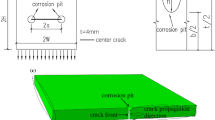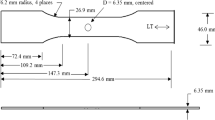Abstract
The interacting effects of internal defects and corrosion pits on the stress concentration factors in hourglass-shaped specimens were investigated through a finite element method investigation. Very high cycle fatigue tests were performed to confirm the shape of the internal defects and the depth of the corrosion pit. According to the experimental observations, a series of three-dimensional models containing internal voids and corrosion pits were established. Stress distribution around the internal void and the corrosion pit under uniaxial tensile loading were obtained. Based on the finite element analysis, the stress concentration factors around the defects were found fully dependent on the structure parameters of the internal void and the corrosion pit. Stress concentration factors increased with the depth-to-length ratios Rd for models with a single corrosion pit. For models with a single internal void, the stress concentration factors increased dramatically when the internal void is present near the surface. Parameters of distance-to-radius ratio (D2 − h)/a and depth-to-length ratio Rd play important roles in the stress distribution for a model with both an internal void and a corrosion pit. Severe stress concentration would be introduced when the parameter (D2 − h)/a < 2. For a deep corrosion pit (i.e., Rd ≥ 1), the stress concentration factors were determined by two parts which were dominated by parameters of (D2 − h)/a and Rd, separately. For a shallow corrosion pit (i.e., Rd < 1), the stress concentration factors were dominated by the interaction of (D2 − h)/a and Rd. Two very close corrosion pit and void were most likely to be an initiation position and gave rise to devastating effects on the very high cycle fatigue performance of the specimens. Empirical equations were proposed to evaluate the relationship between the stress concentration factors and the structural parameters of defects. The obtained quantitative information would be useful for understanding of crack initiation and fatigue life prediction of engineering components.







Similar content being viewed by others
References
H.K.D.H. Bhadeshia, Steels for bearings. Prog. Mater Sci. 57(2), 268–435 (2012)
Z. Zheng, S. Yuan, T. Sun, S. Pan, Fractographic study of fatigue cracks in a steel car wheel. Eng. Fail. Anal. 47, 199–207 (2015)
B. Salehnasab, E. Poursaeidi, S.A. Mortazavi, G.H. Farokhian, Hot corrosion failure in the first stage nozzle of a gas turbine engine. Eng. Fail. Anal. 60, 316–325 (2016)
V.C. Gudla, R. Ambat, Corrosion failure analysis of hearing aid battery-spring contacts. Eng. Fail. Anal. 79, 980–987 (2017)
R. Ebara, Corrosion fatigue phenomena learned from failure analysis. Eng. Fail. Anal. 13(3), 516–525 (2006)
L. Weng, J. Zhang, S. Kalnaus, M. Feng, Y. Jiang, Corrosion fatigue crack growth of AISI 4340 steel. Int. J. Fatigue 48, 156–164 (2013)
R. Pérez-Mora, T. Palin-Luc, C. Bathias, P.C. Paris, Very high cycle fatigue of a high strength steel under sea water corrosion: a strong corrosion and mechanical damage coupling. Int. J. Fatigue 74, 156–165 (2015)
J.R. Donahue, J.T. Burns, Effect of chloride concentration on the corrosion-fatigue crack behavior of an age-hardenable martensitic stainless steel. Int. J. Fatigue 91, 79–99 (2016)
M. Cerit, K. Genel, S. Eksi, Numerical investigation on stress concentration of corrosion pit. Eng. Fail. Anal. 16(7), 2467–2472 (2009)
M. Cerit, Numerical investigation on torsional stress concentration factor at the semi elliptical corrosion pit. Corros. Sci. 67, 225–232 (2013)
A. Ben Ahmed, A. Nasr, A. Bahloul, R. Fathallah, The impact of defect morphology, defect size, and SDAS on the HCF response of A356-T6 alloy. Int. J. Adv. Manuf. Technol. 92(1–4), 1113–1125 (2017)
G.M.D. Almaraz, R.P. Mora, Ultrasonic fatigue testing on high strength steel: effect of stress concentration factors associated with corrosion pitting holes. Int. J. Damage Mech 22(6), 860–877 (2012)
Y. Huang, C. Wei, L. Chen, P. Li, Quantitative correlation between geometric parameters and stress concentration of corrosion pits. Eng. Fail. Anal. 44, 168–178 (2014)
Y. Huang, X. Ye, B. Hu, L. Chen, Equivalent crack size model for pre-corrosion fatigue life prediction of aluminum alloy 7075-T6. Int. J. Fatigue 88, 217–226 (2016)
Y. Huang, T. Gang, L. Chen, Interacting effects induced by two neighboring pits considering relative position parameters and pit depth. Materials (Basel) 10(4), 1–16 (2017)
P. Li, P.D. Lee, D.M. Maijer, T.C. Lindley, Quantification of the interaction within defect populations on fatigue behavior in an aluminum alloy. Acta Mater. 57(12), 3539–3548 (2009)
G. Chai, T. Forsman, F. Gustavsson, Microscopic and nanoscopic study on subsurface damage and fatigue crack initiation during very high cycle fatigue. Int. J. Fatigue 83, 288–292 (2016)
Q.Y. Wang, C. Bathias, N. Kawagoishi, Q. Chen, Effect of inclusion on subsurface crack initiation and gigacycle fatigue strength. Int. J. Fatigue 24(12), 1269–1274 (2002)
V.-D. Le, N. Saintier, F. Morel, D. Bellett, P. Osmond, Investigation of the effect of porosity on the high cycle fatigue behaviour of cast Al–Si alloy by X-ray micro-tomography. Int. J. Fatigue 106, 24–37 (2018)
H.Q. Nguyen, L. Gallimard, C. Bathias, Numerical simulation of fish-eye fatigue crack growth in very high cycle fatigue. Eng. Fract. Mech. 135, 81–93 (2015)
T. Sakai, N. Oguma, A. Morikawa, Microscopic and nanoscopic observations of metallurgical structures around inclusions at interior crack initiation site for a bearing steel in very high-cycle fatigue. Fatigue Fract. Eng. Mater. Struct. 38(11), 1305–1314 (2015)
T. Sakai, A. Nakagawa, N. Oguma, Y. Nakamura, A. Ueno, S. Kikuchi, A. Sakaida, A review on fatigue fracture modes of structural metallic materials in very high cycle regime. Int. J. Fatigue 93, 339–351 (2016)
W. Li, T. Sakai, Q. Li, L.T. Lu, P. Wang, Reliability evaluation on very high cycle fatigue property of GCr15 bearing steel. Int. J. Fatigue 32(7), 1096–1107 (2010)
W. Zhao, Y. Wang, T. Zhang, Y. Wang, Study on the mechanism of high-cycle corrosion fatigue crack initiation in X80 steel. Corros. Sci. 57, 99–103 (2012)
C.Q. Wang, J.J. Xiong, R.A. Shenoi, M.D. Liu, J.Z. Liu, A modified model to depict corrosion fatigue crack growth behavior for evaluating residual lives of aluminum alloys. Int. J. Fatigue 83, 280–287 (2016)
N.O. Larrosa, R. Akid, R.A. Ainsworth, Corrosion-fatigue: a review of damage tolerance models. Int. Mater. Rev. 63(5), 283–308 (2018)
W. Liu, Q. Li, M.-C. Li, Corrosion behaviour of hot-dip Al–Zn–Si and Al–Zn–Si–3 Mg coatings in NaCl solution. Corros. Sci. 121, 72–83 (2017)
M. Weber, P.D. Eason, H. Özdeş, M. Tiryakioğlu, The effect of surface corrosion damage on the fatigue life of 6061-T6 aluminum alloy extrusions. Mater. Sci. Eng. A Struct. 690, 427–432 (2017)
N.E.C. Co, J.T. Burns, Effects of macro-scale corrosion damage feature on fatigue crack initiation and fatigue behavior. Int. J. Fatigue 103, 234–247 (2017)
G.M. Dominguez Almaraz, V.H. Mercado Lemus, J.J. Villalon Lopez, Effect of proximity and dimension of two artificial pitting holes on the fatigue endurance of aluminum alloy AISI 6061-T6 under rotating bending fatigue tests. Metall. Mater. Trans. A 43(8), 2771–2776 (2011)
N.A. Noda, K. Kobayashi, T. Oohashi, Variation of the stress intensity factor along the crack front of interacting semi-elliptical surface cracks. Arch. Appl. Mech. 71(1), 43–52 (2001)
G.M. Dominguez Almaraz, V.H. Mercado Lemus, J. Jesús Villalon Lopez, Rotating bending fatigue tests for aluminum alloy 6061-T6, close to elastic limit and with artificial pitting holes. Procedia Eng. 2(1), 805–813 (2010)
Acknowledgments
This work was supported by the National Natural Science Foundation of China (Grant Nos. 11605106 and 11404192), the Key Research and Development Project of Shandong Province, China (Grant No. 2017GSF220004), the Shandong Province Special Grant for High-Level Overseas Talents and the research fund of Shandong Academy of Sciences (Grant Nos. 2017QN001, 2019GHPY11 and KJHZ201805).
Author information
Authors and Affiliations
Corresponding author
Additional information
Publisher's Note
Springer Nature remains neutral with regard to jurisdictional claims in published maps and institutional affiliations.
Rights and permissions
About this article
Cite this article
Liu, L., Hou, N., Ding, N. et al. Interacting Effects of Internal Defects and Corrosion Pits on the Stress Concentration of Hourglass-Shaped Specimens. J Fail. Anal. and Preven. 19, 967–975 (2019). https://doi.org/10.1007/s11668-019-00682-2
Received:
Revised:
Published:
Issue Date:
DOI: https://doi.org/10.1007/s11668-019-00682-2




